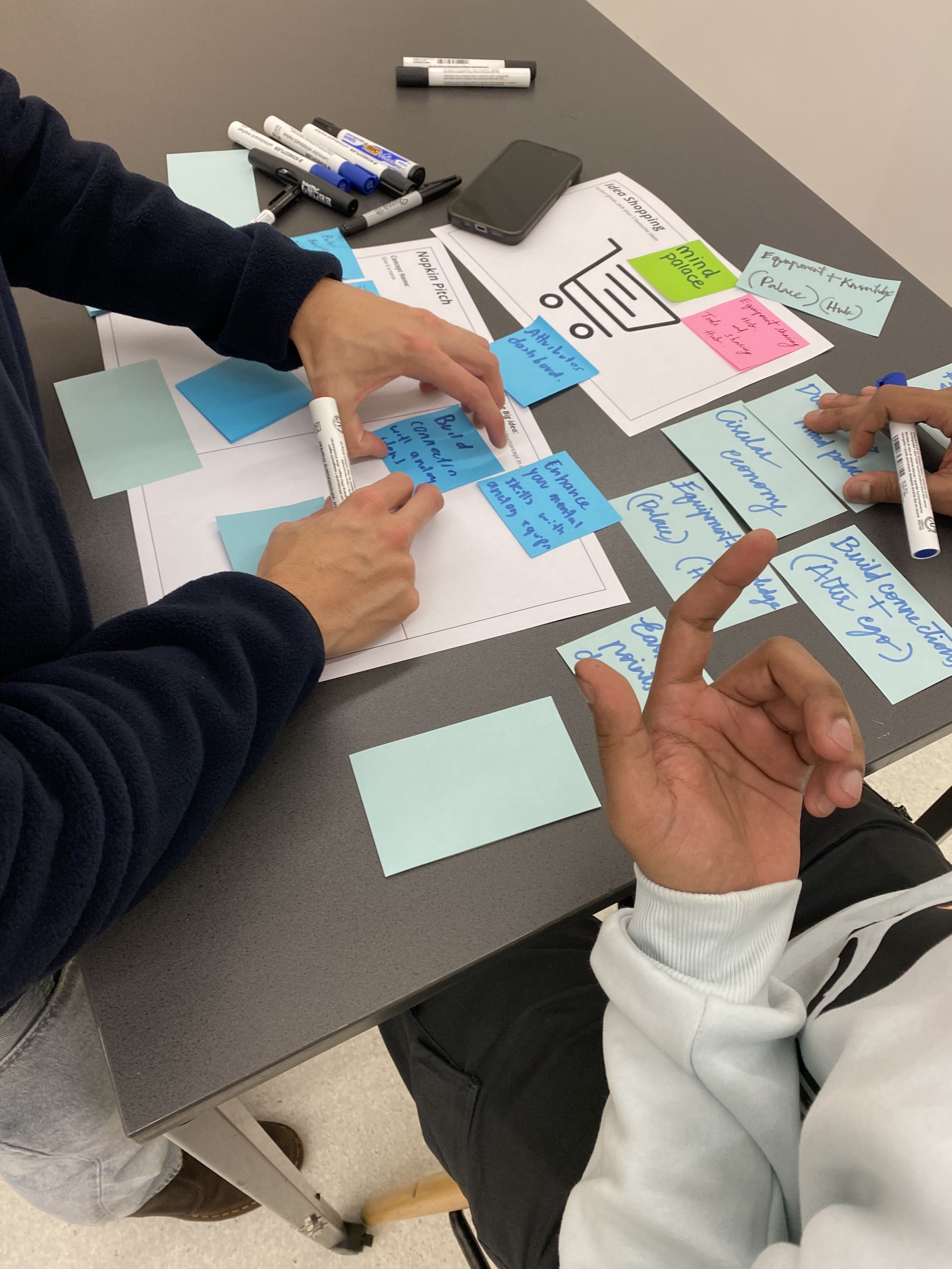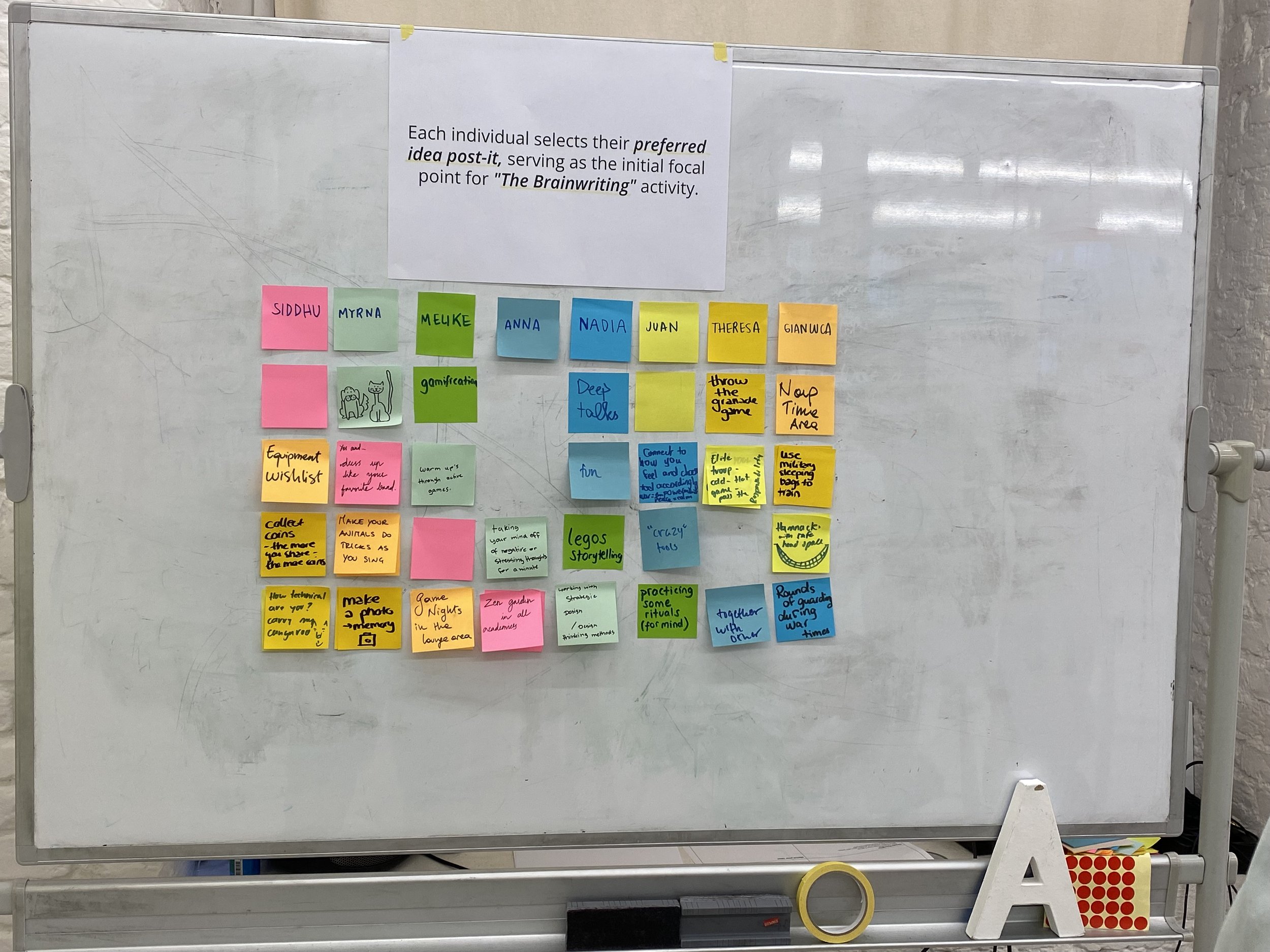
Learning by Doing
A Strategic Design project focused on building an innovation mindset and culture within the Bundeswehr.
Problem Summary
This project was a collaboration between the Bundeswehr (Germany’s Federal Defence Force) and the M.A. Strategic Design program at SRH Berlin University of Applied Sciences. The partnership came at an important time, given ongoing global and political challenges. In a team of 4 (Team Alpha), we worked on finding ways to encourage more innovation within the Bundeswehr, which is known for its strict structure and cautious culture.
Project Details
Duration: October 2023 - March 2024
Team Alpha: Lena Hirsche, Natalia Restrepo, Benjamin Giske, Janak Ghalsasi
Initial Project Brief
How might we create a mobile innovation lab for military changemakers of the Bundeswehr to drive an innovation mindset for solving complex challenges?
Research
During the research phase, we used a mix of qualitative and quantitative methods to explore the Bundeswehr’s culture, structure, and operations. Desk research and benchmarking of innovation labs provided context, while interviews with stakeholders, experts, and users revealed key barriers: risk aversion, rigid hierarchy, and skepticism toward innovation. Online ethnography on Reddit and Instagram highlighted the need for clear communication and addressing real concerns. An immersive visit to Appen Air Base offered firsthand insights into daily routines and emphasized the Bundeswehr’s strong preference for hands-on, experiential learning—shaping the project’s core approach.
Key Insights: A risk-averse mindset, rigid hierarchy, skepticism toward innovation, and the importance of clear communication and addressing real frustrations.
Immersive Learning: Fieldwork at Appen Air Base highlighted the need for hands-on & experiential learning.





Synthesis
During synthesis, the team converted raw data into insights using clustering, the iceberg model, empathy maps, and system maps. Clustering identified themes such as innovation blockers, cultural clashes, and civilian-military mindset gaps. The empathy map revealed emotional tensions—pride mixed with fear of failure—humanizing the problem. The system map illustrated how politics, leadership shifts, and organizational structure, driven by top-down pressure and short-term focus, hinder innovation. The cultural map exposed norms like strict hierarchy and zero-tolerance for mistakes that conflict with creative experimentation.
These insights we derived from our sythesis were further refined into opportunity areas, leading to a reframed challenge for ideation and concept development.
Insight Generation: Clustering, empathy, and system maps turned data into key themes—innovation blockers, emotional tensions, and systemic obstacles.
Cultural Challenges: Deep norms like hierarchy, fear of failure, and zero-tolerance mistakes hinder innovation and creativity.
Opportunity Fields
Opportunity Field 1
Safe Space
Opportunity Field 2
Learning by Doing
Opportunity Field 3
Simplified Language
Opportunity Field 4
Influence of Physical Space
Opportunity Field 5
Connecting the Innovation Community





Initial Project Brief
“How might we create a mobile innovation lab for military changemakers of the Bundeswehr to drive an innovation mindset for solving complex challenges?”
Reframed Project Brief
“How might we create a safe space for military civilians and soldiers to come up with wild/creative ideas without fearing failure, while simplifying innovation and making it more accessible?”
Ideation
The ideation phase was built on insights from research and synthesis, aiming to develop creative, practical solutions to the reframed brief. The team kicked off with a workshop involving SRH MASD students who had joined the Appen immersion. Activities included silent brainstorming, wild scenario ideation, and reimagining military spaces as innovation hubs. Using tools like Brainwriting, Idea Shopping, and the Idea Napkin, participants collaboratively shaped ideas, later tested through role-plays with skeptical military personas to ensure relevance and feasibility.
Throughout, the focus stayed on inclusivity, hands-on engagement, and accessibility. Sketching and visual storytelling helped refine concepts, while the Futures Workshop introduced long-term thinking through megatrends like digitalization and “New Work.” This process led to two core concept directions—both grounded in “learning by doing”—offering a practical framework to foster innovation within the Bundeswehr’s rigid structure and cultural constraints.
Collaborative Workshop: Involving 15+ SRH MASD students using Brainwriting, Idea Shopping, and Idea Napkin to develop ideas, tested through role-play with skeptical military personas.
Ideation Focus Area: Focused on inclusivity, visual storytelling, and hands-on engagement. We also included long-term thinking and megatrends like digitalization and “New Work.”












Learning by Doing
Final Concept
Rooted in the key takeaways of learning by doing, creating safe spaces, and using simplified language, Das Handbuch, a hands-on guide to teaching innovation, and Der Idee Container, a mobile, physical space for team-based learning and creative collaboration, offer practical tools for driving cultural change within the Bundeswehr. Together, they empower changemakers to foster collaboration, experimentation, and trust, making innovation accessible, actionable, and sustainable across teams.
Das Handbuch
The Handbuch, a key outcome of the ideation phase, is a practical tool designed to introduce and support innovation within the Bundeswehr’s hierarchical, risk-averse culture. Targeted at civilian leaders and changemakers, it offers a step-by-step framework with workshops, facilitation tips, ideation tools, and simplified language, all based on a “learning by doing” approach that enables immediate, hands-on application without prior design training.
Aimed at about 400 innovation-minded individuals, the Handbuch helps early adopters lead sessions, creating a ripple effect to spread innovation organically—bypassing bureaucratic obstacles by leveraging existing internal networks. More than a manual, it’s a strategic tool that builds trust through real results and role modeling, making innovation accessible, safe, and repeatable, and laying the groundwork for lasting cultural change in the Bundeswehr.
Approach & Goal: Uses “learning by doing” with simple tools for early adopters without prior design training to learn & spread innovation through peer sessions.
Purpose: A practical, step-by-step toolkit designed to introduce innovation for 400+ innovation-minded individuals in an accessible and hands-on way.















Der Idee Container
The Idee Container is a mobile, modular innovation lab that brings the Handbuch methodology to life by offering a flexible space for creative collaboration and hands-on learning within the Bundeswehr. Inspired by modular military infrastructure like hospital containers, it provides an adaptable setting for teams to safely ideate, prototype, and experiment. Fully equipped with workshop materials and design thinking tools, it can be deployed across various locations—bases, ministries, or training centers—broadening access to innovation.
Beyond functionality, the container symbolizes cultural change. It acts as a “safe space” for risk-taking without fear of hierarchical judgment. Facilitated by internal changemakers trained through the Handbuch, sessions inside the container ensure cultural fit and relevance. Its presence fosters curiosity, bridges civilian-military mindsets, and supports a growing innovation community. Ultimately, the Idee Container creates both the environment and momentum for sustained, decentralized innovation across the Bundeswehr.
Functional & Symbolic Role: Safe space for fostering risk-taking and innovation without fear of hierarchy, challenging the traditional military culture.
Mobile Lab: Modular, flexible space supporting the Handbuch methodology, enabling hands-on learning, collaboration, and prototyping across Bundeswehr.
Cultural Bridge: Led by internal changemakers, it integrates civilian and military mindsets, encourages experimentation, and builds an innovation community.






Testing & Feedback
We tested Der Handbuch in internal workshops with SRH MASD students familiar with the Bundeswehr context. Participants ran mock innovation sessions and role-playing scenarios to assess the toolkit’s usability for non-experts. Feedback emphasized the need for clearer instructions and further simplified language. Based on this input, Der Handbuch’s structure was refined.
At the same time, we conducted low-fidelity A/B testing for Das Idee Container to evaluate how spatial design supports collaboration and psychological safety. Positive feedback highlighted the value of modular setups, visible tools, and flexible workstations.
The refined Der Handbuch was then shared with Bundeswehr stakeholders, including Thomas Belka and his team, who provided extremely valuable feedback. The testing confirmed the strong potential of both tools to foster an open innovation culture, while also identifying key areas for improvement. Detailed feedback from Thomas Belka and his team is shown on the right.
Feedback from Thomas Belka & Team
Positive:
Offers a straightforward guide for newly formed teams or those aiming to address long-term challenges collaboratively.
Designed for ease of use by anyone, even without prior experience in creative thinking.
Critical:
Solving problems internally may be difficult without incorporating external perspectives and feedback.
Feels similar to a standard weekly meeting, potentially lacking depth or novelty.
Has limited impact for teams that already have strong creative synergy.
Stakeholder Validation: Thomas Belka and his team confirmed the tool’s potential to foster innovation, while noting its limited impact for teams that already have strong creative synergy.
Tool & Space Testing: Role-playing sessions and low-fidelity A/B testing provided feedback highlighting the need for clearer instructions, simpler language, and flexible, modular environments to support collaboration.






Roadmap
Following testing, the team created a staged roadmap to implement and scale Das Handbuch and Der Idee Container in the Bundeswehr. The first phase launched pilot programs led by trusted changemakers using the Handbuch in workshops and deploying a prototype Idee Container at select bases. These pilots aimed to build trust, collect feedback, and show practical value in day-to-day challenges. Clear onboarding materials and facilitation support were key.
In phase two, insights from the pilots would inform broader rollout—standardizing the Handbuch and producing adaptable Idee Containers for various contexts. The roadmap emphasized building an internal innovation network to share experiences, mentor newcomers, and evolve practices. Communication efforts would highlight success stories to shift perceptions around innovation. Long-term, the goal is full integration into Bundeswehr training and leadership programs, embedding innovation into the organization’s culture.
Scalable Rollout: Feedback from pilots to improve the tools and roll them out across more Bundeswehr units.
Pilot-Led Adoption: Trusted changemakers run initial workshops and test Der Handbuch and Das Idee Container to build trust and gather real-world feedback.
Culture & Community Focus: Create a network of innovators, share success stories, and get leadership on board to make innovation part of everyday training.






View more case studies.





